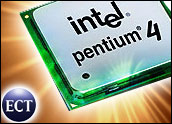
Intel is moving Pentium 4 and Celeron processor technology and capabilities into the mobile space with four new chips aimed at the desktop-replacement and value-mobile markets.
The newest mobile chips from Intel — three Mobile Pentium 4s and a Celeron M — are not cutting edge and not intended for the mainstream mobile market, but rather take some desktop-like features to the mobile segment, allowing use of multithreaded and processor-intensive multimedia applications.
The processors represent the second generation of mobile processors based on the more efficient, 90-nanometer process, Intel said.
Many Things at Once
“For example, a consumer could have a great experience when playing an immersive game while also encoding audio, video or compressing images,” said a statement from the Santa Clara, California-based chip giant.
Meta Group vice president Steve Kleynhans said the new processors represent an effort to bring Pentium 4 capabilities, such as hyperthreading technology, to the notebook market.
“This is certainly not the mainstream of mobility,” Kleynhans told TechNewsWorld. “It’s just a matter of moving forward. This is bringing the latest iteration of Pentium 4 into this mobile space. It’s not revolutionary in any sense. It’s the next, incremental step.”
Something To Lug
Intel said the new Mobile Pentium 4 chips — the 538, 532 and 518 — are designed for larger, desktop replacement notebooks that feature larger screens, full-size keyboards and multiple drives. New features for the mobile space include hyperthreading (HT) support, increased 1-MB Level 2 cache and speeds of 3.2 GHz, 3.06 GHz and 2.8 GHz.
Kleynhans said the key aspect for users is the HT capability, which until now has not been available in notebook processors from Intel. Hyperthreading is a technology that Intel introduced a little over a year ago. It gives a processor the ability to look like two processors to the hardware, which is said to increase performance of many kinds of applications.
“These are primarily for consumers to have a luggable machine to use media around the house,” Kleynhans said.
Intel said the new 1.5-GHz Celeron M processor 340 features 512 KB of L2 cache and operates at a lower core voltage than the previous Celeron. It is intended for the value, thin and light market segment, the company said.
Bottom Up
Gartner research vice president Martin Reynolds told TechNewsWorld that the latest mobile chips from Intel represent a “natural advance for the current platforms” as Pentium M technology makes its way into the Pentium 4 lineup.
“The 90-nanometer process permits faster, more feature-rich Pentium 4 processors to fit inside the power envelope,” he said. “The Pentium M parts reflect the bottom of the line moving up.”
Reynolds said that, in the longer term, the Pentium 4 might be displaced by versions of the Pentium M.
“Historically, Pentium 4 processors in mobile platforms have been price-performance products,” he said. “However, Intel can price Pentium M such that the Pentium 4 makes no sense for mobile applications, except for niche markets where absolute performance in a portable form factor is required.”
Multicore Route
Kleynhans said that, considering Intel’s intention to make all of its processors multicore, use of HT technology in mobile chips appears to be a step in that direction.
“I definitely think this is the route they’re going to go to get more processor power in systems,” he said. “Hyperthreading will be a good way to get there.”
Kleynhans also said that even though the idea of a multicore processor goes against the spirit of low-power and low-heat requirements of notebook computing, Intel likely will move to multicore in mobiles further down the road.





















































